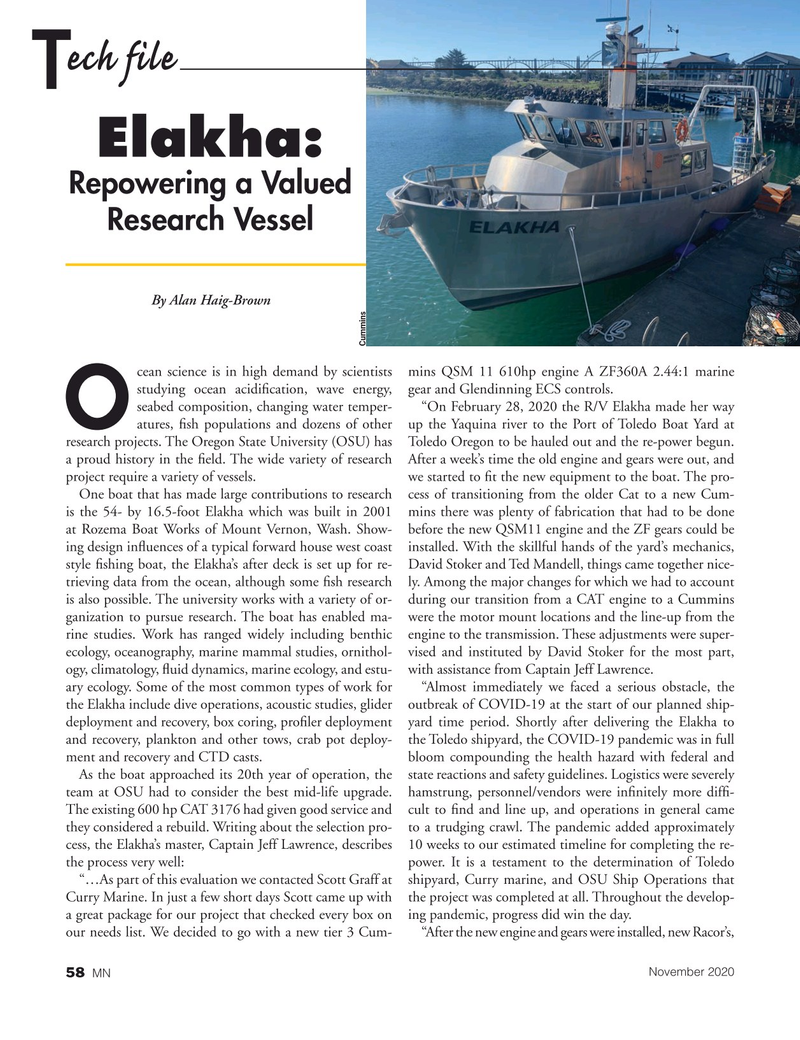
Page 58: of Marine News Magazine (November 2020)
Workboat Annual
Read this page in Pdf, Flash or Html5 edition of November 2020 Marine News Magazine
ech file
T
Elakha:
Repowering a Valued
Research Vessel
By Alan Haig-Brown
Cummins cean science is in high demand by scientists mins QSM 11 610hp engine A ZF360A 2.44:1 marine studying ocean acidi? cation, wave energy, gear and Glendinning ECS controls.
seabed composition, changing water temper- “On February 28, 2020 the R/V Elakha made her way atures, ? sh populations and dozens of other up the Yaquina river to the Port of Toledo Boat Yard at
O research projects. The Oregon State University (OSU) has Toledo Oregon to be hauled out and the re-power begun. a proud history in the ? eld. The wide variety of research After a week’s time the old engine and gears were out, and project require a variety of vessels. we started to ? t the new equipment to the boat. The pro-
One boat that has made large contributions to research cess of transitioning from the older Cat to a new Cum- is the 54- by 16.5-foot Elakha which was built in 2001 mins there was plenty of fabrication that had to be done at Rozema Boat Works of Mount Vernon, Wash. Show- before the new QSM11 engine and the ZF gears could be ing design in? uences of a typical forward house west coast installed. With the skillful hands of the yard’s mechanics, style ? shing boat, the Elakha’s after deck is set up for re- David Stoker and Ted Mandell, things came together nice- trieving data from the ocean, although some ? sh research ly. Among the major changes for which we had to account is also possible. The university works with a variety of or- during our transition from a CAT engine to a Cummins ganization to pursue research. The boat has enabled ma- were the motor mount locations and the line-up from the rine studies. Work has ranged widely including benthic engine to the transmission. These adjustments were super- ecology, oceanography, marine mammal studies, ornithol- vised and instituted by David Stoker for the most part, ogy, climatology, ? uid dynamics, marine ecology, and estu- with assistance from Captain Jeff Lawrence.
ary ecology. Some of the most common types of work for “Almost immediately we faced a serious obstacle, the the Elakha include dive operations, acoustic studies, glider outbreak of COVID-19 at the start of our planned ship- deployment and recovery, box coring, pro? ler deployment yard time period. Shortly after delivering the Elakha to and recovery, plankton and other tows, crab pot deploy- the Toledo shipyard, the COVID-19 pandemic was in full ment and recovery and CTD casts. bloom compounding the health hazard with federal and
As the boat approached its 20th year of operation, the state reactions and safety guidelines. Logistics were severely team at OSU had to consider the best mid-life upgrade. hamstrung, personnel/vendors were in? nitely more dif? -
The existing 600 hp CAT 3176 had given good service and cult to ? nd and line up, and operations in general came they considered a rebuild. Writing about the selection pro- to a trudging crawl. The pandemic added approximately cess, the Elakha’s master, Captain Jeff Lawrence, describes 10 weeks to our estimated timeline for completing the re- the process very well: power. It is a testament to the determination of Toledo “…As part of this evaluation we contacted Scott Graff at shipyard, Curry marine, and OSU Ship Operations that
Curry Marine. In just a few short days Scott came up with the project was completed at all. Throughout the develop- a great package for our project that checked every box on ing pandemic, progress did win the day.
our needs list. We decided to go with a new tier 3 Cum- “After the new engine and gears were installed, new Racor’s,
November 2020
MN 58

 57
57

 59
59
